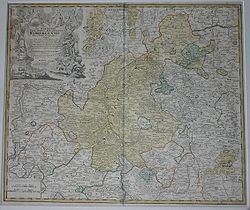Elevated to Prince-Bishopric 1245 Founded 1245 | Government Elective principality Diocese established 1007 Preceded by Succeeded by Capital Bamberg | |
 | ||
The Prince Bishopric of Bamberg was established in 1007, to further expand the spread of Christianity in Germany. The ecclesiastical state was a member of the Holy Roman Empire from about 1245 until it was subsumed to the Electorate of Bavaria in 1802.
Contents
State
The Bishops of Bamberg received the princely title by Emperor Frederick II of Hohenstaufen before his deposition by Pope Innocent IV in 1245, whereby the diocese became an Imperial state.
During the 18th century, it was often held in conjunction with the neighboring Bishopric of Würzburg. Bamberg was bordered, among others, by Würzburg to the west, by the Margraviate of Brandenburg-Ansbach and the Free City of Nuremberg to the south, by the Margraviate of Brandenburg-Bayreuth to the east and by the Duchy of Saxe-Coburg to the north.
The prince-bishopric also ruled over large possessions within the Duchy of Carinthia, including the strategically important towns of Villach, Feldkirchen, Wolfsberg and Tarvisio at the transalpine road to Venice, as well as Kirchdorf an der Krems in the Archduchy of Austria. The Habsburg Empress Maria Theresa purchased these territories in 1759.
In the course of the German Mediatization of 1802/3 which saw the suppression of virtually all the ecclesiastical principalities, Bamberg was annexed to Bavaria. The former prince-bishopric then had an area of 3,580 km² and a population of 207,000.
History
Beginning on 1 November 1007, a synod was held in the city of Frankfurt am Main. Eight archbishops and twenty-seven bishops were present, led by Archbishop Willigis of Mainz, as well as the King of the Romans, Heinrich II (Henry II). The king intended to create a new diocese that would aid in the final conquest of paganism in the area around Bamberg. But the territory of the Wends on the upper Main, the Wiesent, and the Aisch had belonged to the Diocese of Würzburg since the organization of the Middle German bishoprics by St. Boniface, so that no new diocese could be erected without the consent of the occupant of that see. Bishop Henry I of Würzburg was willing to go along with parting with some of his territory, as the king promised to have Würzburg raised to an archbishopric and to give him an equivalent in Meiningen. The consent of Pope John XVII was obtained for this arrangement, but the elevation of Würzburg to an archbishopric proved impracticable also due to Willigis' reservations, and Bishop Henry I at first withdrew his consent.
Nevertheless, after several further concessions, King Heinrich II obtained the consent for the foundation of the diocese of Bamberg from parts of the dioceses of Würzburg and - later - the Diocese of Eichstätt. Bamberg was made directly subordinate to Rome. It was also decided that Eberhard, the king's chancellor, would be ordained by Archbishop Willigis of Mainz, to be the head of the new border area diocese. The new diocese had expensive gifts at the synod confirmed by documents, in order to place it on a solid foundation.
Henry wanted the celebrated monkish rigour and studiousness of the Hildesheim cathedral chapter - Henry himself was educated there - linked together with the churches under his control, including his favourite bishopric of Bamberg. The next seven bishops were named by the emperors, after which election by the cathedral chapter became the rule, as in all the German prince-bishoprics. Eberhard's immediate successor, Suidger of Morsleben, became pope in 1046 as Clement II. He was the only pope to be interred north of the Alps at the Bamberg Cathedral.
In the thirteenth century the diocese gradually became a territorial principality, and its bishops took secular precedence next after the archbishops; Bishop Henry I of Bilversheim (1242-57) became the first Prince-Bishop.
The fortieth bishop, George III of Limburg (1505-22), was inclined toward the Reformation, which caused a violent social outbreak under his successor Weigand (1522-56), and the city suffered severely in the Second Margrave War (1552-54), as well as in the Thirty Years' War, when it was placed under the jurisdiction of Bernard, the new Duke of Franconia.
At the Peace of Westphalia (1648), the prince-bishops recovered their possessions. During the French Revolution, Bamberg was overrun by the French and, in the course of the German mediatization of 1802/3, it was annexed to Bavaria. From 1808 to 1817 the See was vacant; but by the Bavarian Concordat of the latter year it was made an archbishopric, with Würzburg, Speyer, and Eichstädt as suffragan sees.
Patronage
The prince bishops operated courts like minor royalty and employed artists, in particular musicians. Kapellmeisters and organists attached to the court included several minor South German masters such as Heinrich Pfendner, Johann Baal, Georg Arnold and Georg Mengel.
